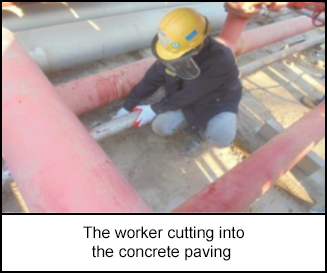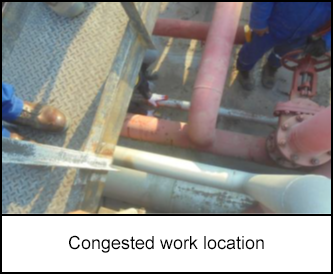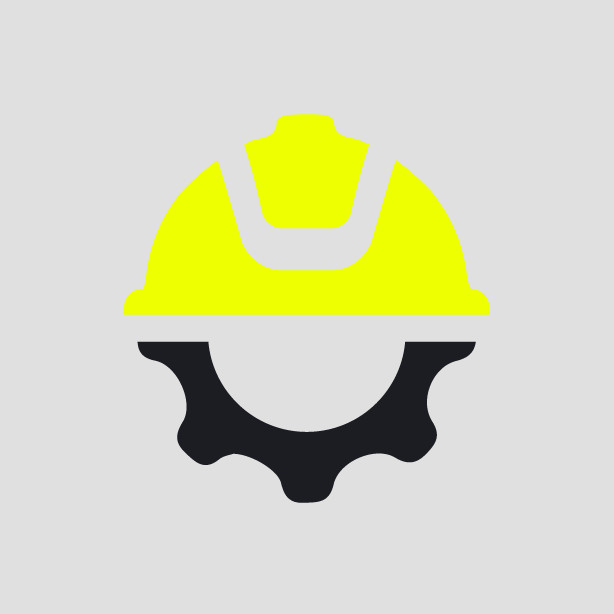-
What happened?
A worker was in the process of cutting a groove into the concrete paving using a grinder and a 4-inch (10cm) cutting disk. The wheel struck into the concrete paving.
The worker then lost control of the grinder causing the cutting disk to make contact with his right wrist resulting in a laceration to the back of his hand.
The activity was performed in a congested area beneath and between existing water pipelines.
The injured person (IP) received stitches on his right hand and returned to site on light duties.

-
Why did it happen?
Congested work location:
- The work location is extremely congested with existing facilities creating inherent risk for safe execution.
- Because of this, the IP had to work in a tight posture which increased the risk of being in the line of fire.
Inadequate risk assessment:
- Location was not adequately assessed by the supervisor to ensure work activity is conducted safely.
- Better in-field hazard identification and risk assessment could have prompted field engineering to create better solutions and ensure safer execution.
Inadequate control of work:
- Use of grinder with cutting disk in congested locations was not adequately addressed in the method statement and respective permit to work (PTW).

-
What did they learn?
Ensure that all work locations are adequately assessed to identify constructability risks.
For activities carried out near existing facilities, inherent safety risks must be clearly identified and addressed through engineering controls to determine safer methods of execution.
The site supervisor must perform a 20-second scan of the work location to confirm that safe execution methods are in place.
Ensure that work method statements and risk assessments are updated to reflect current site conditions, and that appropriate controls are implemented through the relevant PTW system.

-
Ask yourself or your crew
How can something like this happen here (e.g. on our site)?
What safety measures (i.e. procedures, controls/barriers) do we have in place to mitigate the risk?
How do we know the risk controls/barriers are working?
What improvements or changes should we make to the procedures, controls/barriers, or the way we work?

Add to homescreen
Content name
Select existing category:
Content name
New collection
Edit collection
What happened?
A worker was in the process of cutting a groove into the concrete paving using a grinder and a 4-inch (10cm) cutting disk. The wheel struck into the concrete paving.
The worker then lost control of the grinder causing the cutting disk to make contact with his right wrist resulting in a laceration to the back of his hand.
The activity was performed in a congested area beneath and between existing water pipelines.
The injured person (IP) received stitches on his right hand and returned to site on light duties.

Why did it happen?
Congested work location:
- The work location is extremely congested with existing facilities creating inherent risk for safe execution.
- Because of this, the IP had to work in a tight posture which increased the risk of being in the line of fire.
Inadequate risk assessment:
- Location was not adequately assessed by the supervisor to ensure work activity is conducted safely.
- Better in-field hazard identification and risk assessment could have prompted field engineering to create better solutions and ensure safer execution.
Inadequate control of work:
- Use of grinder with cutting disk in congested locations was not adequately addressed in the method statement and respective permit to work (PTW).

What did they learn?
Ensure that all work locations are adequately assessed to identify constructability risks.
For activities carried out near existing facilities, inherent safety risks must be clearly identified and addressed through engineering controls to determine safer methods of execution.
The site supervisor must perform a 20-second scan of the work location to confirm that safe execution methods are in place.
Ensure that work method statements and risk assessments are updated to reflect current site conditions, and that appropriate controls are implemented through the relevant PTW system.
Ask yourself or your crew
How can something like this happen here (e.g. on our site)?
What safety measures (i.e. procedures, controls/barriers) do we have in place to mitigate the risk?
How do we know the risk controls/barriers are working?
What improvements or changes should we make to the procedures, controls/barriers, or the way we work?
A worker sustained a hand injury while cutting concrete in a confined space. Contributing factors included workspace congestion and insufficient risk controls.














